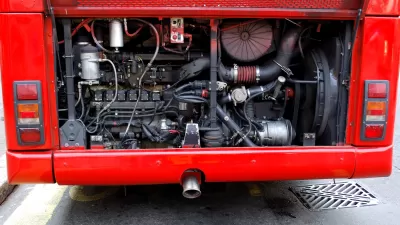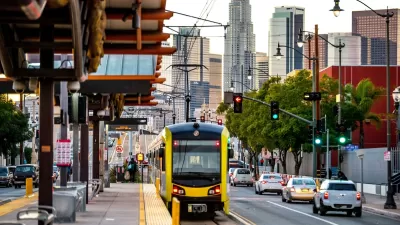In much of the United States, day-to-day transit service is under assault as never before; state and local treasuries have been depleted by the recession, and the federal stimulus package is unlikely to be helpful because federal dollars are more likely to flow into capital programs (English translation: shiny new railcars) than into preserving existing service (1). Thus, Americans will have the worst of both worlds: billions thrown at transportation while existing bus routes get whittled away.
In much of the United States, day-to-day transit service is under assault as never before; state and local treasuries have been depleted by the recession, and the federal stimulus package is unlikely to be helpful because federal dollars are more likely to flow into capital programs (English translation: shiny new railcars) than into preserving existing service (1). Thus, Americans will have the worst of both worlds: billions thrown at transportation while existing bus routes get whittled away.
How can we save public transit? One option might be to increase federal subsidies for transit agencies' operating expenses- but this may not be politically viable, since Congress has traditionally been reluctant to support operating expenses, and the enormous cost of bank bailouts and stimulus package may have sated Congress' appetite to increase government spending.
However, tax cuts are generally less controversial than spending increases: Republicans are nearly always willing to support tax cuts, while moderate Democrats are willing to support some tax cuts in order to appeal to more conservative voters. Moreover, tax bills are generally not filibustered, so 50 Senate votes rather than 60 will be sufficient to pass a tax cut.
So why not a tax cut for transit? Specifically, I propose the following: a $1000 per year tax credit for weekly and monthly transit passes. Transit agencies in need of revenue could raise the cost of transit passes, and could inform riders that they would be able to get the money back when they paid their taxes. As a result, more people would buy transit passes, and transit agencies would no longer be drowning in red ink.
In addition, a transit policy based on tax credits rather than subsidy increases would empower consumers rather than empowering bureaucrats. One common argument against subsidizing operating expenses is that federal subsidies are wasted by bureaucrats, and thus never really benefit transit riders. By contrast, under a tax credit plan, a transit agency's interests would be aligned with those of riders: the agencies most able to appeal to riders would get the most funding, while less competent transit agencies would get less.
How much would such a plan cost? Roughly 5% of American workers, or about 7 million Americans, regularly commute via public transit.(2) Assuming that this number of Americans spend $1000 per year on transit passes(3), the credit would cost $7 billion - not very much in the context of a $3 trillion federal budget. If transit ridership increased so much that the drain on the Treasury significantly exceeded this amount, Congress could always reduce the size of the credit.
It could be argued that increasing the cost of monthly passes would harm low-income transit users, who can ill afford to spend $80 a month for a transit pass. But in fact, even these riders would benefit in two ways. First, increased use of passes would enable transit agencies to protect existing service, thus protecting lower-income riders from losing bus service altogether. Second, the extra revenues received by transit agencies would enable them to hold daily fares down, also protecting low-income riders.
To be sure, some cities' riders would benefit more than others: in the best transit systems (such as those of New York and Washington) the cost of a monthly transit pass is higher than $1000 per year, while in more automobile-dependent cities, transit passes are currently far less expensive. But this is an argument in favor of a $1000 cap. Given that resources are scarce, surely it is more important to ensure that people in car-dependent cities have a minimally adequate bus service than to give gold-plated service to people who already benefit from America's best transit systems.
(1) For one of many articles on this subject, see http://planetizen.com/node/37255
(2) http://www.census.gov/prod/2008pubs/09statab/trans.pdf, Table 1060.
(3) It may be that more Americans would purchase transit passes, since (a) a number of transit riders are too old or young to work, and thus do not count as "commuters" and (b) this plan is likely to increase ridership. On the other hand, some transit riders will not purchase passes, either because they cannot afford passes or do not ride often enough. And a few other riders will simply be too careless to take advantage of the credit. My somewhat educated guess is that these groups will cancel each other out, and that the total number of credit users would be about 7 million.

Alabama: Trump Terminates Settlements for Black Communities Harmed By Raw Sewage
Trump deemed the landmark civil rights agreement “illegal DEI and environmental justice policy.”

Planetizen Federal Action Tracker
A weekly monitor of how Trump’s orders and actions are impacting planners and planning in America.

The 120 Year Old Tiny Home Villages That Sheltered San Francisco’s Earthquake Refugees
More than a century ago, San Francisco mobilized to house thousands of residents displaced by the 1906 earthquake. Could their strategy offer a model for the present?

Opinion: California’s SB 79 Would Improve Housing Affordability and Transit Access
A proposed bill would legalize transit-oriented development statewide.

Record Temperatures Prompt Push for Environmental Justice Bills
Nevada legislators are proposing laws that would mandate heat mitigation measures to protect residents from the impacts of extreme heat.

Downtown Pittsburgh Set to Gain 1,300 New Housing Units
Pittsburgh’s office buildings, many of which date back to the early 20th century, are prime candidates for conversion to housing.
Urban Design for Planners 1: Software Tools
This six-course series explores essential urban design concepts using open source software and equips planners with the tools they need to participate fully in the urban design process.
Planning for Universal Design
Learn the tools for implementing Universal Design in planning regulations.
Clanton & Associates, Inc.
Jessamine County Fiscal Court
Institute for Housing and Urban Development Studies (IHS)
City of Grandview
Harvard GSD Executive Education
Toledo-Lucas County Plan Commissions
Salt Lake City
NYU Wagner Graduate School of Public Service






























